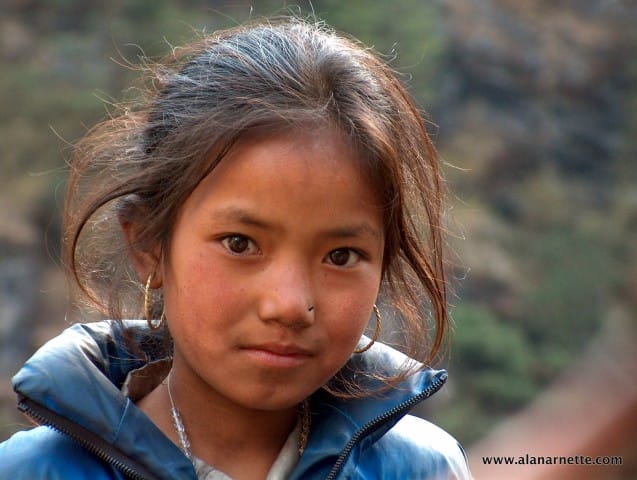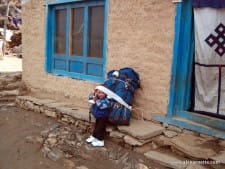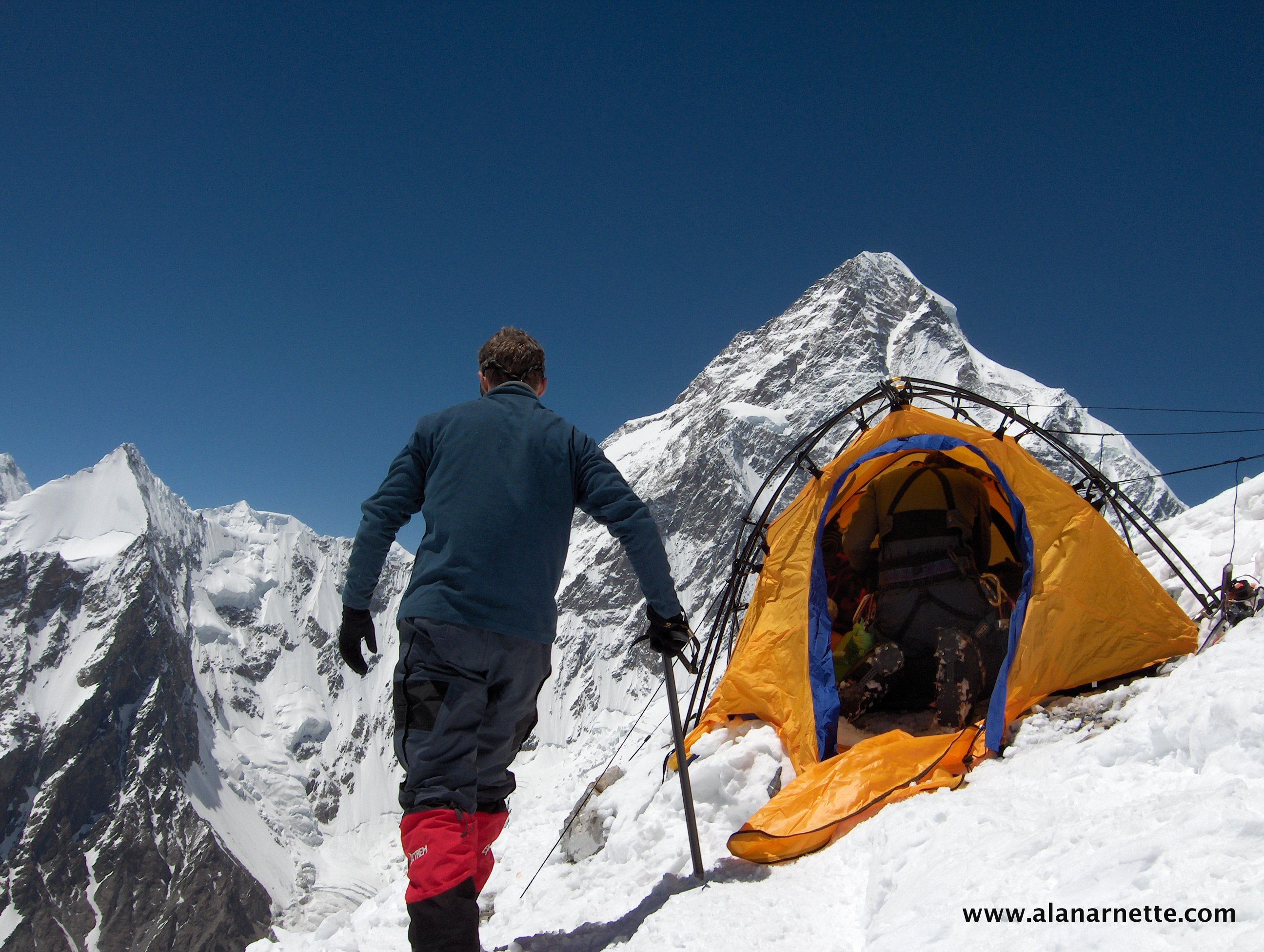As I climb the world to end Alzheimer’s, hospital I have taken thousands of photographs. I am posting many on Facebook over the next few months and will do a weekly summary post here on my site. I hope you enjoy them.
Manaslu
Manaslu is known as one of the “achievable” 8000 meter mountains at 26, 759 feet 8156 meters but also one of the more deadly. In 2012, 11 climbers were killed by an avalanche that hit directly on Camp 3 and in 1972, 15 climbers died.
In 2013, I climbed with Phil Crampton on this beautiful peak. Known for harsh weather, we trekked in at the end of the monsoons in overcast skies and constant rain, but were rewarded with amazing waterfalls, and lush green forests.
Base Camp often has endless days of rain and heavy snow – all in all not the most comfortable place. The crux of Manaslu is fairly low for an 8000m mountain, being between Camps 1 and 2 where the terrain is steep, filled with crevasses and ice walls.
But once you clear the lower sections, the upper mountain is open, exposing the sharp, and well defined summit that can be seen from Camp 4 at 24,500’/8156m.
Of all my climbs, I’ve never experience a summit like Manaslu. I took this picture from the summit, careful not to lose my balance. As I turned around to descend, it was like rotating on a dinner plate.
You can read more about my Manaslu climb at this link

Memories
Be careful what you say in public! While on a climb last year, I was talking about my climbing and work as an Alzheimer’s Advocate. While I knew there were people around as it was a large group climbing together, I didn’t know everyone there. One person was listening in on the conversation.
Chris Mueser heard my story and had a similar feeling about pursuing a purpose in life. Mine is being an Alzheimer’s Advocate, Chris chooses to take note of situations and contribute as he can. He says:
“… the realization I made is that sometimes purpose is not necessarily defined by an end, but by the means of how we live our lives minute by minute. Purpose is dynamic. Something we can choose to change on the spot, if we are in tune with the world around us I realized that purpose is indeed played out every minute of our lives.“
So months later Chris met a very talented painter, Suzanne Yazzie. Suzi often paints pictures of individuals with Alzheimer’s, or their pets, for them and their family. As they talked, my name came up and they decided to honor me with a panting.
My climbing friends soon got involved and last Thursday night at a surprise gathering, they gave the painting to me. I was shocked beyond belief that two people whom I really don’t know, would put such a huge effort into a gift for someone they really don’t know. Also, I’m forever grateful to my friends who took part in this and kept the secret for months.
The painting is me on the summit K2 last year and captured a moment, a memory, in my life that was both a high and a low. As I was climbing to the summit of K2 on my birthday, I developed fluid in my lungs or pulmonary edema. I never considered turning back, as strange as that sounds.
When I was standing on the summit, struggling to breath, I took out that picture of Ida, my mom who had died from Alzheimer’s Disease in 2009, and held it up with tears in my eyes and pride in my heart. A photo was taken, a picture was panted, and a memory is now forever sealed.
You see, yes, I climb to summit and for the joy it brings me but I don’t climb for personal recognition. I climb for a greater meaning. I speak on behalf of those who can’t or choose not to from s to families to caregivers. Sometimes we need to share the burden, sometimes we need to carry part of the load.
Over $70,000 was donated for Alzheimer’s research and 5 million people were touched during that climb.
My eternal gratitude to all, for all.

Snowmass Mountain, Colorado
I often post pictures of my climbs on the world’s highest mountains. But since I live and train in Colorado, my beloved 14ers, the 53 or 54 or 58 mountains higher than 14,000 feet – depending on how you count them – are my playground.
In training for Manaslu, the summer of 2013, I climbed 25 of the 14ers over several months. One of my favorites was a backpacking trip to Snowmass Mountain at 14,092′ in the Elk Range near Aspen.
The climbing was fun requiring crossing snowfields and navigating a sharp rock ridge to reach the summit. But the camp site and hike in was extraordinary.
As a boy, I would read magazines like Outdoor Life and Field and Stream lusting over the pictures of hikers with big pack packs in remote mountains.
On this trip, my dreams came true.

Kami
Thanks to many of you who made donations to help Kami Sherpa who was injured on K2 this year. I spoke live with him a few weeks ago and tonight received a message from him that he is healing nicely and will return to Pangboche next month to began to rebuild his home that was damaged in the April earthquake. He wanted me to thank everyone for all their generosity. This picture is of Kami on K2 in 2014.

Shishapangma
Attempting Shishapangma in 2007 was a highlight of my climbing CV. While I didn’t summit, it was rewarding to go deep into Tibet and climb a mountain that is so isolated and often lonely.
We spent several weeks traveling to base camp via Lhasa and then doing acclimatization rotations. One picture is of our Camp 2 at 7100m or 23,300 feet. Then there is one of me with my ever-present sat phone making a voice dispatch to my website. And the view from Camp1 looking over the Tibetan Steps – the picture doesn’t capture the beauty.
All was going well until we received an updated weather forecast of heavy snow and high winds … for the next 30 days – and that was that!
You can read more about my Shishapangma climb at this link



Khumbu Icefall
The Khumbu Icefall serves as the gatekeeper, or some would say the Troll to climbing Mt. Everest from the Nepal side. First spotted by George Mallory in 1921, he deemed it impossible to climb, too dangerous and turned his attention to the climbing from the Tibet side. Of course one of the great mountaineering mysteries is whether Mallory and his partner Sandy Irvine summited then died or died during the ascent in 1924.
Today, the Icefall remains the object of fear as it has taken too many lives. In 2014, 16 Sherpas were killed by an ice serac release off the West Shoulder of Everest, The Sherpas were waiting for a ladder to be replaced across a deep crevasse and were hit by falling ice.
As dangerous as the Icefall is, the category of “falls” accounts for the majority of deaths on Everest at 90, with the Icefall claiming a tragic 31 lives. But kept in perspective, the historical summit to death rate is similar whether climbing from Tibet 3.98%, or Nepal, 4.1%.
With my four climbs on Everest (one summit in 2011) and my 2015 attempt on Lhotse, stopped by the earthquake; I have been through the Khumbu Icefall 27 times and crossed the ladders over 125 times.
It is always an experience as you start well before sunrise when the snow and ice are the strongest, and in theory, there is a lower risk of avalanches. With headlamps showing the way, you approach each ladder carefully.
Your first instinct is to see how deep the crevasse is, if its dark, it’s probably better as some of the crevasses go all the way to North America! Next you see how many ladders are lashed together.
Many crossings are only one ladder but some can be three, four or even seven. The longest ones keep you focused as when in the middle, a slight bounce develops growing into a wave. You squat slightly to lower your center of gravity, slowing the bounce, hoping no one else chooses to follow behind too quickly.
The safety lines serve as a placebo. You have clipped two leashes from your harness onto the thin nylon rope anchored into the snow at each end of the ladders. You scan ahead and see one end tied to an ice screw bobbing in the snow, the heat of the day has melted the anchor loose. If you fall, this safety will fail. Don’t fall.
The first step takes you off the earth and into the air. The wind picks up slightly. Great. Your eyes are now focused on your boots, the front points of your crampons. Carefully you move your toes ahead, an inch off the rungs of aluminum ladder. With a reassuring click, your crampon points engage the next rung, your heel settles into the previous rung.
Step by step you make progress across the ladders, never moving your eyes from your boot. The ever-present chatter of the Sherpas, takes your attention off your task for a moment, but you don’t look up.
All of a sudden you feel the safety lines go taught. A Sherpa at your destination has squatted down pulling back on both ropes to make them tight, easier to move your leashes and carabiners along. Now you are making faster progress.
Reaching the end of the ladders, you quickly unclip the ‘biners. And suddenly you remember – you need to breath.
You can read more about my Everest climbs at this link.



Trekking in the Khumbu
October is traditionally when the largest number of trekkers go to Nepal. The Annapurna Circuit, Mansalu Circuit, Langtang or the Khumbu – there are many choices.
The spring earthquakes of 2015 damaged some regions, specifically the Langtang area was badly hit but the others range from minor to almost no damage and are open for business.
In 1997, I made my first trek in Nepal. It was to Everest Base Camp and included side trips to the Goyko Lakes and up the Chukhung Valley – it changed my life.
My memories are of a time of wonderment and inspiration …
Careful to avoid a few large rocks on the well worn dirt trail, my eyes kept going upwards, ever higher trying to see the tops of the highest peaks in the world, the Himalayas in Nepal. Our trekking team was making good progress on that cool crisp October morning. Low clouds hid the summits.
I was deep in thought as to what I was seeing, what I was feeling, what I was experiencing when the silence was broken by the laughter of children – the children of the Khumbu. “Namaste” they seemed to scream as loudly as possible, quickly followed by giggles.
They rushed to me as if I was a rock star, hands out, palms upright. In 1997, they wanted a dollar bill, rupees or chocolate but today, they ask for a pen, a writing pen for school.
The clouds soon cleared to reveal Ama Dablam, not one of the giants, but one of the most beautiful mountains in the world. I suddenly stopped, I had never seen anything like this mountain.
I stared, tracing the skyline from bottom to top, pausing to inspect the huge hanging ice bulge – the dablam. I dismissed it as a climbing goal but summited it three years later – one of my early lessons from the Khumbu that nothing is impossible.
Sitting crossed legged in the Monastery, I let my mind relax, my breathing became rhythmic. Soon I was in my own version of a trance, taken there by the gentle chants of Buddhists monks. The sound was repetitive, a low deep baritone melody of only a few notes.
Who are these people, how do they live? A million more questions occupied my mind as I watched them sit side by side on flat wooden benches, kept warm by heavy crimson robes yet their feet were bare. Their heads bobbed in unison to the chanting only interrupted with an occasional sip of tea.
All of a sudden a huge clang of symbols broke the tranquility, then a steady boom, boom, boom, boom of a drum. The evil spirits driven away, the monks returned to their chanting.
As I walked out of the monastery, I my eyes strained to adjust to the bright sun in clear blue skies. Clean white snow capped the mountains surrounded me. The contrast of color, heights, the grace of a soft breeze against my face, the sounds of monks and trekkers moving on with their day – all came together in a moment.
It was a memory of a lifetime.
You can read more about my Khumbu trek climbs at this link: and a F.A.Q.







Porters
On my third attempt of Everest in 2008, I hit the depths of self pity, dissolving self esteem and low self confidence. The spring season was a disaster for most expeditions with the Chinese effectively closing the north side in order to carry the 2008 Olympic torch to the summit without demonstrations.
At the last minute, I switched to the south with a loosely formed team. As I reached the exact same spot I had in 2002 and 2003, I let my doubts take over. I focused on all the reasons I couldn’t summit and failed to find one reason to push myself through the self imposed wall I imagined at 27,300 feet.
I reed to the South Col and then to base camp, consumed by the negativity that comes with getting close to a hard goal, not reaching it and discovering who you are in difficult times.
I rushed out of Everest Base Case alone, only accompanied by two porters, both well under 20 years old. They each carried my physical load, a 50b duffel bag each. I carried my load of doubts, regrets, betrayal and pity. We walked together from base camp to Lukla.
As I walked, deep in my own world, trying to find a meaning in what I had just experienced, the boys walked along by my side – steady, full of purpose, not one word of complaint even under the heavy physical loads.
After three days, when we finally reached Lukla, they dropped my duffles with a sigh of relief. As they stood up straight, they both smiled at me and began to walk away. I called out to them, walked over and extended my hand. As we shook hands, I saw in their eyes, what I had been missing.
They were doing their job, expecting little in return. They were generous in spirit, with their charge and committed to the goal. I reached deep in my pocket, and pulled out a small amount of money for me but a month’s wages for them. Their smile became larger, their handshake out of control with movement.
I had learned a valuable lesson that day.
The porters are often ignored in Nepal and on many treks around the world. Silently doing their jobs for a pittance, the customer is often oblivious to their sacrifice and contribution.
These pictures are my way of acknowledging these unsung heroes of the Khumbu.

Climb On!
Memories are Everything
Alan









